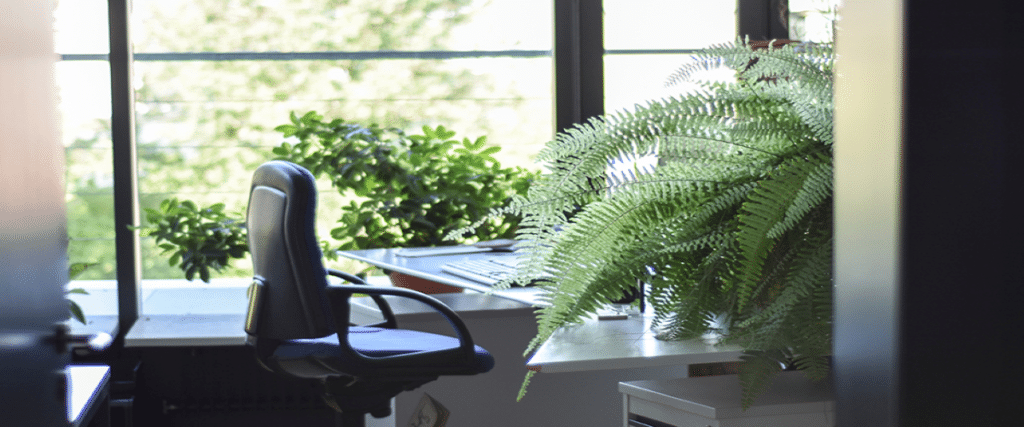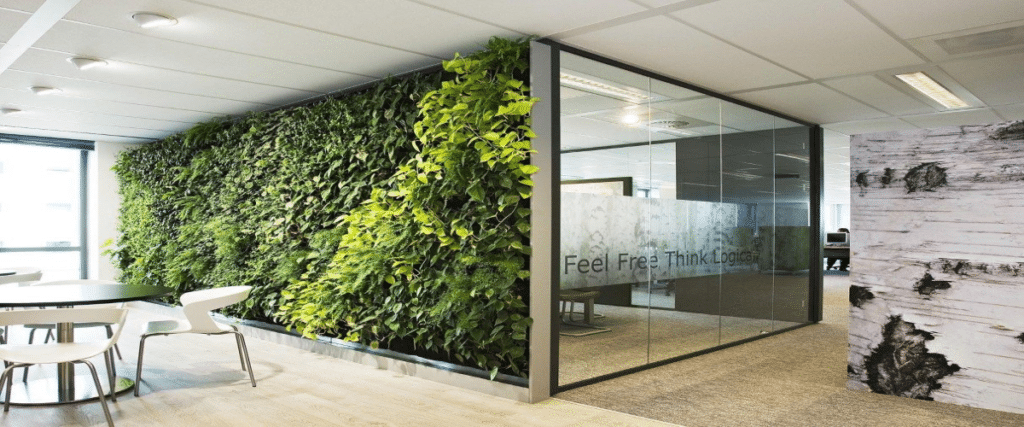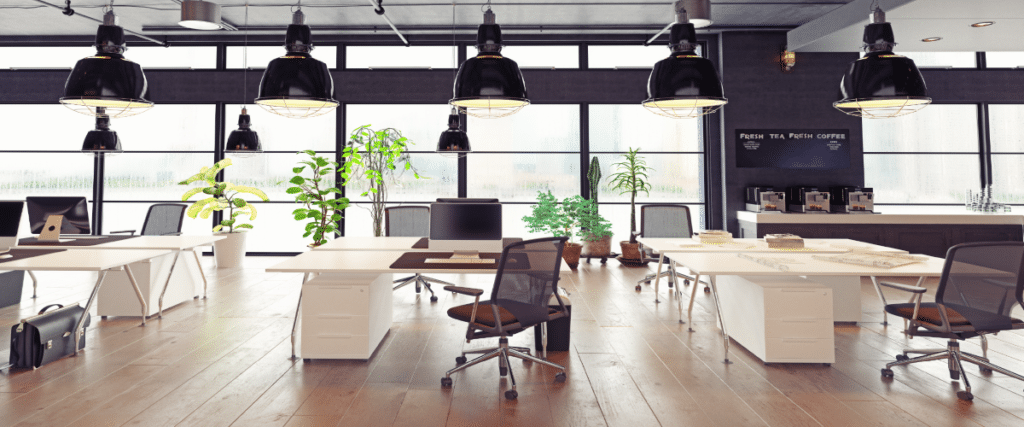
15 May How to Incorporate Biophilic Design in Your Office
Most of us take an innate delight during everyday encounters with nature, whether it’s listening to the trickle of raindrops or watching birds through the window. We instinctively know that nature is good for our wellbeing, and as a species, we’re built to live in and connect with the natural world around us.
Biophilic design studies the way in which we can benefit from bringing natural elements into built environments, which, according to research, can keep us healthier and happier.
In this blog, we’ve covered a few ideas, which you can utilise to bring biophilic elements into your office environment.
A Room with a View

Heart rate recovery from office stresses is said to be 1.6 times faster when one has access to a natural view. Stress is a common factor for loss of productivity in the office, so it’s essential that you use this information to create a calmer and more dynamic working environment.
Strategically placed windows give occupants the chance to benefit from engaging and calming landscapes. Glass fascia’s and balconies can help to enhance physical and visual proximity to the outdoors.

Image from Pinterest
In many working environments, however, this won’t be possible. In this case, pictures, wall art and video loops of natural scenes are a great option and will help to give the office some personality.
Indoor Plants

Image from raconteur.net
Natural elements don’t always have to remain outside; you can bring nature indoors by incorporating plants into the office.
In addition to creating a biophilic element, plants reduce carbon dioxide, urban heat island effect and improve the overall quality of the air circulating around the office.
Also known as eco walls, green walls and vertical gardens – living walls are panels of plants grown vertically using hydroponics. They can sometimes be physically connected to the wall, or incorporated as free-standing structures. However, you decide to include a living wall; they can be a fantastic modern design flourish for any office.
As well as improving air quality and boosting productivity, living walls can be created even when space is at a premium, and they can also reduce energy bills by keeping the building warmer in winter and cooler in summer.
Access to Fresh Air
Fresh air isn’t just invigorating; it’s also been shown to improve concentration and productivity. Airflow also helps to prevent a phenomenon called sick building syndrome.
While most buildings will regulate ventilation and temperature, resulting in a similar experience for everyone in the office, biophilic design seeks to mimic outdoor variability while giving more control to the individual.
To accomplish this, try to create workspaces with a range of temperature and airflow levels, using elements such as solar heat gain and open windows, which should work alongside mechanical heating, cooling and ventilation options.
Natural ventilation is more important during the colder months, so it’s essential to find other methods of maintaining air quality.
Natural Light

Image from Medium.com
Research has long touted the benefits of natural light when it comes to productivity; however, more recent findings are focused on ‘illuminance fluctuation’.
Daylight changes from yellow to blue to red, throughout the course of the day. The circadian rhythm of our bodies uses these transitions to produce the correct balance of serotonin and melatonin. This hormonal balance is intrinsically linked to wellbeing and sleep quality.

Image from Open Sourced Office
It’s important to create as much natural light as possible to ensure the body is able to process the different periods of the day correctly. You can also help by creating layers of light source, using shadow, reflection and by avoiding extreme lighting such as glare.
You may wish to consider:
- Opening out the space – One of the simplest ways to make the most of any natural light you currently have within the office, is to create an open-plan space. Glass partitions, allows the natural light to travel unobstructed throughout the office too.
- Minimising design – It’s not enough to just allow natural light to illuminate the office; it must be actively encouraged. Large pieces of furniture will obstruct natural light and negate much of the benefit of windows and skylights, so try to think carefully about the kinds of furniture you have and where you’re placing it.
- Installing shiny surfaces – A typical design hack to maximise natural light flow is installing polished surfaces, such as mirrors and bright desks. Sleek surfaces rather than matte finishes are far more capable of reflecting light from the windows, and these surfaces can be anything from desks and counters, to cabinets and partitions.
Environmental Acoustics
We seldom spare a thought to the sound of our environment until it begins to interfere with our work. Biophilic design strives to produce environmental acoustics that dynamically promotes increased wellbeing.
In offices, acoustic ceiling panels can help to absorb artificial echoes and help to make indoor acoustics sound more natural. They can also prevent the soundwaves of distracting noises, such as printers, spreading across the office.
However, preventing unwanted noise is only the first step, since offices can either be too loud or too quiet. For offices that are situated near water sources and more natural elements, which are becoming increasingly prevalent for newly built office complexes, it can be a case of allowing natural noises in from outside. For offices, where this isn’t possible though, subtle soundtracks are often quite helpful.
Incorporate Biomorphic Design
Biophilic isn’t solely about trying to bring the outside in; it’s entirely possible to integrate natural elements into that which is manmade.
Materials such as stone, wood and other natural textiles can help you bring nature indoors; you can also use naturally occurring patterns within your furniture, architecture and art choices. Anything from honeycomb, leaf and flower patterns are all great things to experiment with when you’re trying to bring natural elements into the workplace.
Takeaways
Before using any biophilic design elements in your office refurbishment project, it’s important to consider how these changes will contribute to your overall business strategy.
The effect of each biophilic design element is far more critical than the overall volume. In other words, this means that successful biophilic design depends solely on selecting the right features to complement the space, and more importantly, the occupants.
If you’d like to learn more about biophilic design, or you’re interested in any of our other services, don’t hesitate to contact us for more information.

Sorry, the comment form is closed at this time.